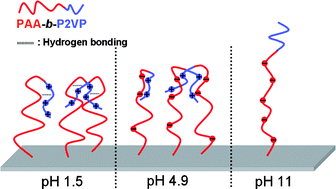Effect of block sequence and block length on the stimuli-responsive behavior of polyampholyte brushes: hydrogen bonding and electrostatic interaction as the driving force for surface rearrangement
Abstract
Diblock polyampholyte brushes with different block sequences (Si/SiO2/poly(acrylic acid)-b-poly(2-vinylpyridine) (PAA-b-P2VP) brushes and Si/SiO2/P2VP-b-PAA brushes) and different block lengths were synthesized by sequent surface-initiated atom transfer


 Please wait while we load your content...
Please wait while we load your content...